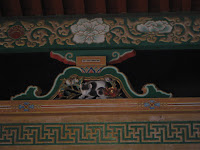
At the rest-stop where I took the above picture, there was a small shrine for warding off motion sickness. You hit a tree stump three times with a bat, then you kick it three times, and then you scream. Interesting.
I'm sure it's no surprise, but I would like to go back to Nikko someday and see more of the little town. There are a number of other shrines there, as well as a wall of clay figures that sounds very interesting. As it was, we saw a temple and a shrine that were quite impressive.
First, we went through the Rinno-ji temple, which is famous for two things: its beautiful Shoyo-en Garden and the three large Buddha figures in the main building (which did not permit photographs). Both sights are worth seeing. Oto-san is very interested in Buddhist iconography, and through Benni-sensei, was able to explain much of what we were seeing. Which helped Benni-sensei too, who seems to have only the slightest grasp of Buddhist and Shinto traditions. This isn't unusual, I've found.

The next stop was the very extensive Toshogu shrine, which was built to house the body of Tokugawa Ieyasu, the first shogun of the peaceful Edo period. It's truly beautiful, even though it's currently under a great deal of reconstruction. Inside the buildings, photographs are not permitted, but the outside is open to cameras of all kinds. There are a number of famous carvings found in the Toshogu shrine, and you can find them by watching all the people who are gathered around them. They're all quite small in comparison to the rest of the shrine's sights.
These are the three wise monkeys: Hear No Evil (Kikazaru), Speak No Evil (Iwazaru), and See No Evil (Mizaru). Although this is not where they originated, this is perhaps the most famous depiction of them. They're a series of carvings describing the life cycle of the monkey from giddy childhood to more austere adulthood. Of course, that is in itself an allegory of the life of man.
And this is nemuri-neko, the sleeping cat. Small as it is, it's considered a national treasure in Japan, crafted by a famous carver named Hidari Jingoro. Its detail is astounding, which is what makes it so popular. Nemuri-neko is said to embody the spirit of Tokugawa Ieyasu, who himself was considered the manifestation of a Buddha of Healing, who comforts the sick and heals illnesses. This little carving is over the doorway that leads to the 200 steps that go up to the shogun's surprisingly simplistic burial site.

Considering Ieyasu is said to embody a healing Buddha, it relates to the Yakushi-do Hall, the Hall of the Medicine Buddha (no pictures, please). This hall is known for a dragon painting on the ceiling (very impressive), and a monk is on hand to strike a pair of blocks that release a sharp, piercing sound that echoes throughout the room. It's said to resemble the cry of a Japanese dragon. Eerie. But the best part was watching the expression on Benni-sensei's face. I had bowed to my writer's nature and done my research - but Benni-sensei was as innocent as a child. It was cute.
After leaving Toshogu, we were starving, so we headed out of the temple area to look for a place to eat a late lunch. One of the things that Nikko is also famous for is yuba, which is basically tofu skin. Sounds gross, right? Which of course means that it's delicious. I had it with hot soba noodles (which I adore anyway). Yummy. Or, as the family said, Oishii!
And then it was time to go home. The kids and oka-san fell asleep on the way home, while Benni-sensei and I talked travel talk. She wants to move back to the States (she's actually waiting for a Green Card approval), and she was fairly surprised when I told her that I'm not interested in moving back to the States any time soon. She loves the States, really misses L.A. The grass is always greener, isn't it?
I have still more pictures (no surprise there), but I haven't uploaded them to Facebook yet. I must give kudos to my camera, which has put up with plenty the past two weeks. Just as we entered the Toshogu shrine, it began to warn me that the batteries were almost kaput. I used it sparingly (ha ha, as in about another 40 pictures), and it's still going. Although it's still very insistent about getting new batteries.
Thus ends my New Year's vacation. I'm left with more taste for traveling, and maybe this is an auspicious start to the year. I'm already doing research into where I want to go next. Benni-sensei suggested Ise, which is home to some of Japan's most sacred Shinto shrines.







No comments:
Post a Comment